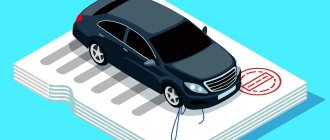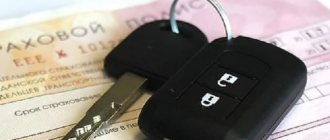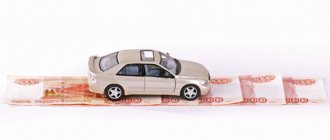Some facts
The first car loan appeared in Russia in 1992. Over the history of car loans, the conditions for providing them have changed a lot. There is a tendency to further simplify the system for issuing such loans.
Taking out a loan to purchase a car is the most common service among borrowers. Loans are simultaneously classified as collateral; until the loan debt is paid off, no contractual actions (sell, exchange) can be made with the car. Removing an encumbrance from a car (removing restrictions in relation to it) is carried out in several ways.
Types of vehicle encumbrances
An encumbrance placed on a vehicle is a restriction on the rights of its owner, expressed in the inability to dispose of the vehicle, for example, rent it out or sell it.
Encumbrance can be expressed by the following types of restrictions:
- pledge. This encumbrance is applied to ensure the fulfillment of obligations under the loan issued by the borrower, as a result of which the citizen is deprived of the right to dispose of movable property until final settlement with the lender;
- arrest. This measure is used to ensure future claims of the creditor, to force the debtor to pay the debt, and sometimes to preserve property. The arrest may be imposed by a court, law enforcement agencies or bailiffs;
- car loan This is a type of pledge, the subject of which is a car. In this case, the vehicle purchased using credit funds remains at the disposal of the bank until the amount of the debt and the interest accrued on it are repaid, and in case of non-payment, it is transferred to the ownership of the creditor.
How to remove an encumbrance from real estate through court
The plaintiff is asking for the mortgage registry to be cleared. An agreement for the sale and purchase of an apartment was concluded between the plaintiff and the defendant. Part of the money to pay for the apartment was paid at the time of concluding the contract, and the remaining amount after registration, which led to the apartment being encumbered with collateral by force of law (clause 5 of Article 488 of the Civil Code of the Russian Federation). The rest came later, after which the defendant wrote a receipt for full payment for the apartment, but avoided filing an application with Rosreestr. The court took into account that, according to the receipt presented in the case materials, the defendant received full payment from the plaintiff under the purchase and sale agreement. By virtue of clause 1 of Art. 408 of the Civil Code of the Russian Federation, proper performance terminates the obligation. The defendant did not submit any objections to the claim, and did not dispute the fact that the plaintiff paid the price of the apartment purchase and sale agreement. The court satisfied the claims.
3.4. The subject of personal data may at any time withdraw his consent to the processing of personal data. To revoke consent to the processing of personal data, you must submit a corresponding application to the Operator via available means of communication. At the same time, the Operator must stop processing them or ensure the termination of such processing and, if the preservation of personal data is no longer required for the purposes of their processing, destroy personal data or ensure their destruction within a period not exceeding 30 (Thirty) days from the date of receipt of the specified review .
- Increase the term of the contract . The client continues to pay principal and interest. But by increasing the loan term, the monthly payment decreases.
- Providing credit holidays . If the client finds himself in a difficult situation, he may be given a deferment in repaying the loan. He will continue to pay off the accrued interest.
- Loan refinancing . If the borrower has several loans issued at the same time, then by combining them into one, the size of the monthly payment will be significantly reduced.
Applying for a secured loan is a responsible step. This decision must be well-weighted and thoughtful, since the amount of the loan received will be significant. If the client has overestimated his financial capabilities or is too over-leveraged, then sooner or later he will have problems repaying the loan.
Checking the car for restrictions
Today, in order to check a car for certain encumbrances, it is not necessary to visit the traffic police department; this can be done without leaving home.
It is enough to have access to the Internet, through which you can visit the official website of the department. In the vehicle verification section, you must enter the data requested by the search engine.
Remember! To do this, you will need certain information from the title and vehicle registration certificate. The official website of the State Traffic Safety Inspectorate provides information about the vehicle’s registration history, its participation in an accident, whether it is wanted and whether there are any restrictions imposed on the vehicle.
The electronic option for providing this type of service does not replace the possibility of personal contact with the State Traffic Inspectorate. To do this, you need to go to the traffic police department and submit a written request for information on the vehicle of interest.
In addition, you can get information about the car in other available ways:
- request on the FSSP website. To obtain information, you will need the details of the vehicle owner and his passport details. Based on the results of the inspection, the applicant receives information about the presence (absence) of encumbrances. The provision of information is free of charge;
- contact the Credit Bureau. The databases of such bureaus contain information not only about borrowers, but also about collateral, including vehicles pledged to lenders;
- visit a notary's office. All cars transferred as collateral are entered into a special state register, to which private notaries have access. Since notary services are paid, the applicant will have to pay a certain amount for providing information. The cost of providing information will vary depending on the region of residence of the applicant.
Refinancing as a way to remove restrictions
The third method is more risky, since it will be possible to remove the encumbrance from the car, but with the threat of getting a new one. Refinancing involves drawing up a new loan agreement to pay off the old one. People turn to other banking institutions for this, although there is the option of taking out a new loan from the previous bank.
To do this, you need an application indicating the amount to repay the debt, as the purpose of signing the agreement is stated as “lending to pay off a debt in another bank.” After the new lender agrees to the refinancing agreement, the funds are transferred to the bank where the loan was issued for the car. The debt is considered repaid, and the encumbrance is removed from the car, transactions are allowed to be made with the vehicle and contracts are signed.
Find out how to check your car for encumbrances here.
Collateral and car loan
These types of encumbrances are removed only subject to full settlement with the creditor. As soon as the borrower makes the final payment, he has the right to return the vehicle documents stored by the lender with a note that the encumbrance has been removed.
Usually this is the original vehicle passport.
When removing an encumbrance on a car loan or other loan issued on the security of a car, you must follow a certain procedure:
- pay off your debts in full;
- contact the State Traffic Inspectorate (sometimes the bank does this on its own after closing the loan);
- provide a package of documents according to the list established by the department (usually a passport, a car mortgage, a title document, a certificate confirming the fulfillment of obligations to the creditor);
- Based on the results of the application, the former borrower is issued a corresponding notice of removal of the encumbrance. From this moment on, the owner of the vehicle has the right to dispose of the property at his own discretion.
Watch the video. What to do if a car is restricted:
What are the legal grounds for deregistering a car as collateral?
Deregistration of a vehicle is carried out at the request of the new or former owner. The procedure is carried out by traffic police specialists. When deregistering, it is not checked whether the car is pledged, since this data is not reflected in the registers or documents for the car.
Here are the nuances that may arise if the owner applies to deregister a car secured by a bank:
- if the reason for deregistration is theft or destruction of a vehicle, there are no consequences for the owner, since the bank’s consent is not required in this case;
- if an application to the traffic police is submitted upon disposal of a damaged car, the bank’s consent is also not required, since the car ceases to physically exist and is not sold;
- if the car is deregistered after sale or donation, the traffic police will not be able to refuse to cancel the registration, but the bank will be able to demand full repayment of the loan or cancellation of the transaction with the car;
- if the cancellation of registration is carried out by decision of a court or a traffic police official, in this case there are also no consequences for the borrower, since he did not violate the terms of the loan agreement.
Thus, traffic police specialists are not obliged to check the presence of a deposit and will not be able to refuse deregistration under any circumstances.
Dear reader! Didn't receive an answer to your question? Our expert lawyers work for you. It's absolutely free!
- Moscow ext 152
- St. Petersburg ext 152
- All regions ext 132 (Toll free)
When establishing collateral, the loan agreement carefully spells out all the consequences for the borrower if he decides to sell the car without the bank’s consent. In any case of deregistration, the main loan obligation will remain unchanged.
Additional measures of influence on the borrower may be:
- an increase in the interest rate, as the bank’s risks increase significantly;
- the onset of the obligation to completely close the loan (if the borrower refuses to do this, the bank will most likely sue);
- compensation for losses and expenses of the bank associated with the loss of rights to the collateral (for example, the bank will be able to recover the costs of legal proceedings).
It is possible to withdraw the collateral from the car early without paying off the loan in full. For example, you can provide other expensive collateral (real estate, securities), agree on restructuring or refinancing under the contract. But the final decision is always made by the bank, so you can demand the removal of the collateral only after the loan obligations have been repaid.
Seized
A seizure placed on a vehicle can only be lifted by the authority that imposed it, except in cases where the actions of the official can be challenged in court. Ultimately, the possibility of lifting such a restriction directly depends on the basis for its application.
For example, if a seizure is imposed by a court as security for the plaintiff’s claims, only the court can remove it provided that the defendant fulfills the obligations assigned to him.
What is a car lien?
Often car owners do not know about the encumbrance of the car
As with real estate, an encumbrance is a restriction on the right to sell, exchange, or gift a car to a third party.
In fact, the encumbrance of a car is the seizure of movable property until the obligations to the pledgee are repaid. There are several types of collateral for a car:
- bank loan secured by a car;
- arrest;
- car loan (similar to a mortgage);
- bail for non-payment of fines.
Before purchasing, it is better for the buyer to independently check the vehicle for restrictions and liens. Often the seller himself does not know that the car is seized.
Who can seize your car
It is worth protecting yourself from problems not only for those who are just buying a car, but also for experienced vehicle owners. Understanding how to place a lien on a car will save you from a lot of unpleasant situations. The following have the right to seize movable property:
- Court. In case of debt to the state or bank, division of property or serious offenses, the court makes a decision to seize the car. Federal bailiffs are required to execute a court order as quickly as possible.
- Investigators. If the owner of a vehicle is a suspect in a criminal case, representatives of the law have the right to confiscate the car or impose restrictions on it.
- Traffic police officers. Participation in a traffic accident and changes to the body number of the car are reasons to prohibit the owner from deregistering the car.
- Customs services. If the car was brought into the country illegally, customs officers have the right to seize your property.
Only the government agency that issued the decision on the seizure or encumbrance can remove the seizure from the car.
If the car is wanted
It is worth immediately emphasizing that this type of restriction cannot be removed. However, you need to contact the State Traffic Inspectorate at least to verify the authenticity of the information.
It is possible that the vehicle was entered into the wanted database by mistake. In this case, the information will be corrected, and registration actions with the car will be allowed.
If it turns out that the car is really wanted, the car will be inspected, the information will be clarified, it will be seized and returned to the owner.
Reasons for termination of bail
The grounds for termination of bail are listed in Art. 352 of the Civil Code, according to which the main reason is the termination of the obligation secured by the encumbered property, i.e. full repayment of the debt.
It is also possible to remove the encumbrance from a car if:
- the vehicle was acquired by a person who did not know and should not have known about the encumbrance;
- there was a complete loss of movable property;
- the borrower obtains permission from the bank to sell the “credit” car;
- the pledge agreement is terminated or declared invalid;
- a corresponding court decision has been made;
- the car was seized on the basis of the transaction being declared invalid (Article 167 of the Civil Code) or the debtor depositing money with a notary or court (Article 327 of the Civil Code);
- the car is sold to satisfy the requirements of the previous mortgagee (clause 3 of Article 342.1 of the Civil Code).
Also, additional reasons for terminating the encumbrance may be specified in the collateral agreement concluded between the borrower and the bank.
Resolving issues in the bank
Regardless of what kind of property is pledged, the main document allowing the removal of the encumbrance is an official certificate from the bank stating that the loan obligations have been repaid in full and the credit institution has no claims against the borrower.
To resolve the issue, you must contact your bank and ask for the relevant document. Usually this requires writing an application, but during a personal visit with a passport, a verbal request is sufficient. Some banks are even ready to prepare a separate or joint application with the borrower with a request to the registration authority to remove the encumbrance from the collateral.
Sample statement of claim for recognition as a bona fide purchaser of a car
N. entered into a pledge agreement No. dated August 5, 2011, according to which the borrower provided a Mazda-6 car as collateral, identification number No., engine number No., PTS No. (hereinafter referred to as the Pledged Car).
That is, the new owner of the car bore all the obligations of the previous owner in terms of the mortgagor, unless otherwise provided by the terms of the agreement.
It should be noted that by the time a civil case is initiated, the car may be resold several times. In such cases, all participants in the sales chain of the pledged car are involved in the case as co-defendants.
In judicial practice, situations quite often arise when a secured creditor misses the statute of limitations for filing a claim for debt collection under a loan agreement in court.
The natural way
A car loan implies that the purchased car will be collateral throughout the entire borrowing period.
Moreover, all actions related to its alienation will also be prohibited until you repay the debt to the bank. As a rule, a car loan is taken out for a period of 3-5 years. And, regardless of whether you repaid the loan ahead of schedule or regularly made payments throughout the entire term, the final moment of closing the car loan will be the removal of the encumbrance from the vehicle.
All pledged cars are registered in the relevant state register. It is in it that a record is stored confirming that your car is collateral. To remove the encumbrance from it, you will need a document from the bank confirming that you have no debt and no claims from the creditor. However, your task will only be to close the loan correctly and keep a certificate of no claims; the lender will handle the rest. As soon as the encumbrance is over, you will receive a title and become the full owner of the car.
Sample letter for withdrawal from property pledge
The content should contain the following information:
- Basis for purchasing the car (documents) + date of transaction;
- Data of a specific car (date of manufacture, make, model, equipment, etc.);
- Papers that the buyer received along with the car;
- The amount transferred to the seller for the vehicle;
- Date of registration of ownership, fact of receipt of a license plate - with links to data on the traffic police website;
- Additional information (insurance contract, independent examination);
- How long the plaintiff had been using the car when the car was seized;
- Location of transport in storage for another matter;
- References to legislative norms in connection with which and on the basis of which the application is being submitted.
Here you should list the documents provided by the seller of the vehicle, on the basis of which the buyer concluded that the purchase and sale transaction is legal and no additional verification is required.
The court noted that there is no direct rule on this in Russian legislation - this conclusion was made on the basis of a set of substantive law rules.
After this, you should also refer to another link (clause 2, part 1, article 352 of the Civil Code of the Russian Federation), according to which, based on the listed facts, the pledge (or seizure) from the designated property should be removed, and the property itself should pass into the possession of the new owner .
Removal of encumbrance - general procedure
Removing a deposit from a car involves two stages:
- full repayment of the loan with receipt of the relevant certificate;
- removal of encumbrances from state registration authorities.
At the same time, each bank can establish its own procedure: in some, the procedure for removing the encumbrance is simplified as much as possible, in others, additional formalities are required.
Therefore, before contacting the bank, you should carefully study the loan agreement to see if there are additional documents or actions to remove the collateral.









